SQL is one of the most widely used languages in the modern world. SQL is very necessary to deal with relational databases. SQL stands for Structured Query Language. It allows a user to insert, update, search, and delete database records.
SQL itself isn’t a programming language. However, its standard permits making procedural augmentations for it, which extends it to the usefulness of a developed programming language. Thus, it has become quite essential to own some proper SQL books to learn this language.
SQL is a necessary instrument for business investigators, as they can effortlessly concentrate information from a database using SQL. Additionally, for making or altering the database outline, embedding new information, and updating the current one, and for information questioning, business investigators use SQL. SQL is also used in Finance, as it is quite useful for data transactions. Thereby, the uses of SQL are uncountable.
Best SQL Books
If you are a newbie and you want to dive deep into learning this language, then a perfect set of SQL books is indecipherably important for you. Obviously, there are thousands of books that you will see when you start searching for one, and that can definitely be intimidating.
Therefore, we will provide you with the most fundamental books that you need to learn SQL. These books accommodate their own ways. Not only are they beneficial for newbies but also for advanced programmers who want to brush up their skills a bit.
1. SQL All-In-One For Dummies
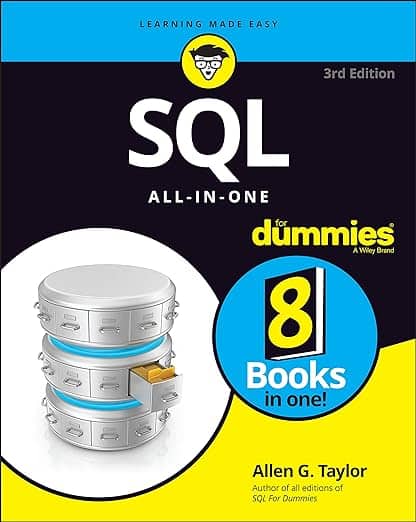
If you are a complete newbie, then this book is heaven for you. It contains 8 books in one, and therefore, there is absolutely nothing that you can miss out on while learning SQL. At first, it talks about the basic things you need to understand before diving deep into SQL: normal SQL concepts, relational database development, SQL queries, etc. After that, it moves to data security and SQL programming and, finally, some super interesting topics like how we can store and retrieve XML data using SQL as well as data tuning.
Table of Contents
Book I
- Understanding Relational Databases
- Modeling a System
- Getting to Know SQL
- SQL and the Relational Model
- Knowing the Major Components of SQL.
- Drilling Down to the SQL Nitty-Gritty
Book II
- System Development Overview
- Building a Database Model
- Balancing Performance and Correctness
- Creating a Database with SQL
Book III
- Values, Variables, Functions, and Expressions
- SELECT Statements and Modifying Clauses
- Querying Multiple Tables with Subqueries
- Querying Multiple Tables with Relational Operators.
- Cursors
Book IV
- Protecting Against Hardware Failure and External Threats
- Protecting Against User Errors and Conflicts
- Assigning Access Privileges
- Error Handling
Book V
- Database Development Environments
- Interfacing SQL to a Procedural Language
- Using SQL in an Application Program
- Designing a Sample Application
- Building an Application
- Understanding SQL’s Procedural Capabilities
- Connecting SQL to a Remote Database
Book VI
- Using XML with SQL
- Storing XML Data in SQL Tables
- Retrieving Data from XML Documents
Book VII
- Tuning the Database
- Tuning the Environment
- Finding and Eliminating Bottlenecks
2. Sams Teach Yourself SQL in 10 Minutes
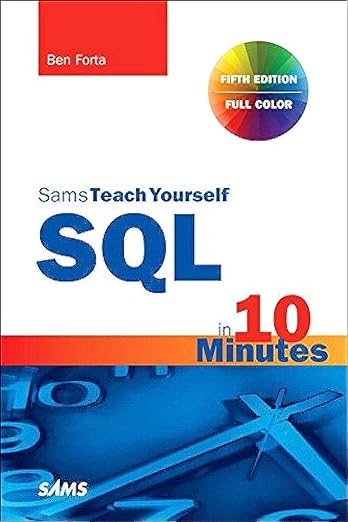
Among the different SQL books out there, this book will teach you exactly what you have to know, beginning with basic information retrieval and recovery and rapidly taking a shot at increasingly complex subjects, including the utilization of joins, table requirements, subqueries, cursors, triggers and put away methods. This is by far the most nonpareil SQL book you can get for learning SQL, and it is definitely worth your time.
Table of contents
- Understanding SQL
- Retrieving Data
- Sorting Retrieved Data
- Filtering Data
- Advanced-Data Filtering
- Using Wildcard Filtering
- Creating Calculated Fields
- Using Data Manipulation Functions
- Summarizing Data
- Grouping Data
- Working with Subqueries
- Joining Tables
- Creating Advanced Joins
- Combining Queries
- Inserting Data
- Updating and Deleting Data
- Creating and Manipulating Tables
- Using Views
- Working with Stored Procedures
- Managing Transaction Processing
- Using Cursors
- Understanding Advanced SQL Features
3. SQL QuickStart Guide – The Simplified Beginner’s Guide To SQL

If you are worried that you have absolutely no idea or knowledge of SQL, this is the SQL book that you should put your hands on, as this book will take you from knowing completely zilch about SQL and databases to mastering core parts of database programming. Everything in this book is very simply written; thus, it makes it almost effortless for anyone to learn SQL from here.
Table of contents
Retrieving Data with SQL
- The SELECT Statement
- The FROM Clause
- Limiting Data by Specifying Columns
- SQL Predicates
- Returning DISTINCT Rows
- TOP
- The WHERE Clause
- Comparison Operators
- Logical Operators
- Dealing with Ranges & Wildcards
- Operator Precedence
- The ORDER BY Clause
- Using Aliases with the AS Clause
- Selecting Records from Multiple Tables
- Including Excluded Data with OUTER JOIN
- NULL Values
- COUNT
Built-in Functions and Calculations
- SUM
- Other Functions
- Grouping Data with the GROUP BY Clause
- Limiting Group Results with HAVING
Entering and Modifying Data
- INSERT Information INTO the Database
- Updating Data
- Deleting Data from Tables
Defining Databases
- Creating/Deleting a Database
- Data Types
- Characters
- Numerical Data
- Date & Time
- Defining Tables
4. Teach Yourself SQL in 21 Days
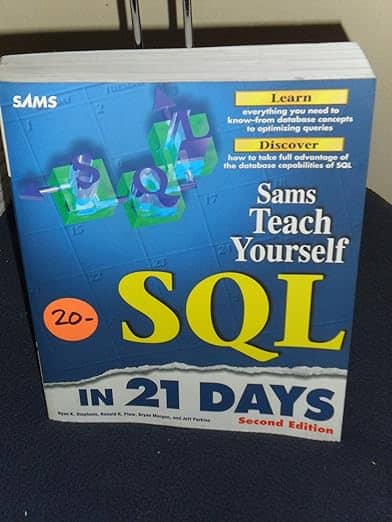
This book was specially written for those who want to learn SQL in a very short time and start to get into work. This is the SQL book that not only will be useful for a beginner but also for those who want to brush up their skills on SQL before going to an interview or work.
The book is divided very smoothly; that is, it sets you up in a time frame to learn this language and thereby acts as a major motivation for those who feel like learning a new language would take forever. So everything you need to know, from the foundation to the zenith, is all in one book.
Table of Contents
Week 1
- Day 1 Introduction to SQL
- Day 2 Introduction to the Query: The SELECT Statement
- Day 3 Expressions, Conditions, and Operators
- Day 4 Functions: Molding the Data You Retrieve
- Day 5 Clauses in SQL
- Day 6 Joining Tables
- Day 7 Subqueries: The Embedded SELECT Statement
Week 2
- Day 8 Manipulating Data
- Day 9 Creating and Maintaining Tables
- Day 10 Creating Views and Indexes
- Day 11 Controlling Transactions
- Day 12 Database Security
- Day 13 Advanced SQL Topics
- Day 14 Dynamic Uses of SQL
Week 3
- Day 15 Streamlining SQL Statements for Improved Performance
- Day 16 Using Views to Retrieve Useful Information from the Data Dictionary
- Day 17 Using SQL to Generate SQL Statements
- Day 18 PL/SQL: An Introduction
- Day 19 Transact-SQL: An Introduction
- Day 20 SQL*Plus
- Day 21 Common SQL Mistakes/Errors and Resolutions
5. MySQL in a Nutshell
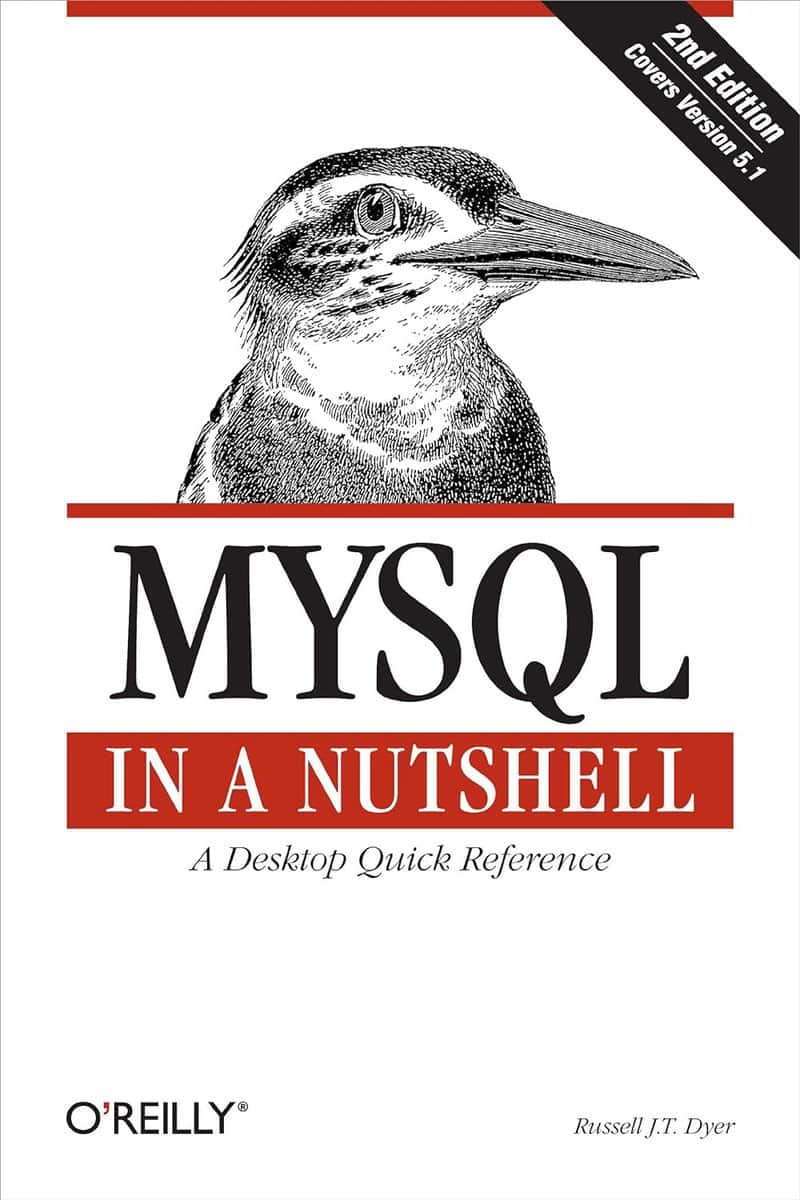
MySQL is the world’s most popular open source database, and it is rich in features, as already mentioned earlier. If you are a data administrator or even a programmer, with this book in your hand, you can drill down into the full depth of MySQL’s capabilities. This MySQL book has all the vital details distilled into one convenient, well-organized destination, which will help you to learn all the facts you need to tap MySQL’s capabilities at your fingertips.
Table of Contents
- Introduction to MySQL
- Installing MySQL
- MySQL Basics
- SQL Statements
- String Functions
- Date and Time Functions
- Mathematical and Aggregate Functions
- Flow Control Functions
- Miscellaneous Functions
- MySQL Server and Client
- Command-Line Utilities
- Perl API
- PHP API
- C API
6. Learning SQL

Among the various SQL books that you will come across, this book is one of the most user-friendly and communicative SQL books that you will put your hands on. It is delineated in such a way that it can be a guide for beginner or intermediate users interested in the fundamentals of SQL.
The first twelve chapters cover the basics of data types, tables, and primary keys and also include exercises at the end of each chapter. The final three chapters include some advanced topics that build upon SQL commands. There are also three appendices at the end. One is on Entity Relationship Diagrams, one is on MySQL Extensions, and the other is the solution to the Exercises.
Table of Contents
- A Little Background
- Creating and Populating a Database
- Query Primer
- Filtering
- Querying Multiple Tables
- Working with Sets
- Data Generation, Conversion, and Manipulation
- Grouping and Aggregates
- Subqueries
- Joins Revisited
- Conditional Logic
- Transactions
- Indexes and Constraints
- Views
- Metadata
7. Managing & Using MySQL
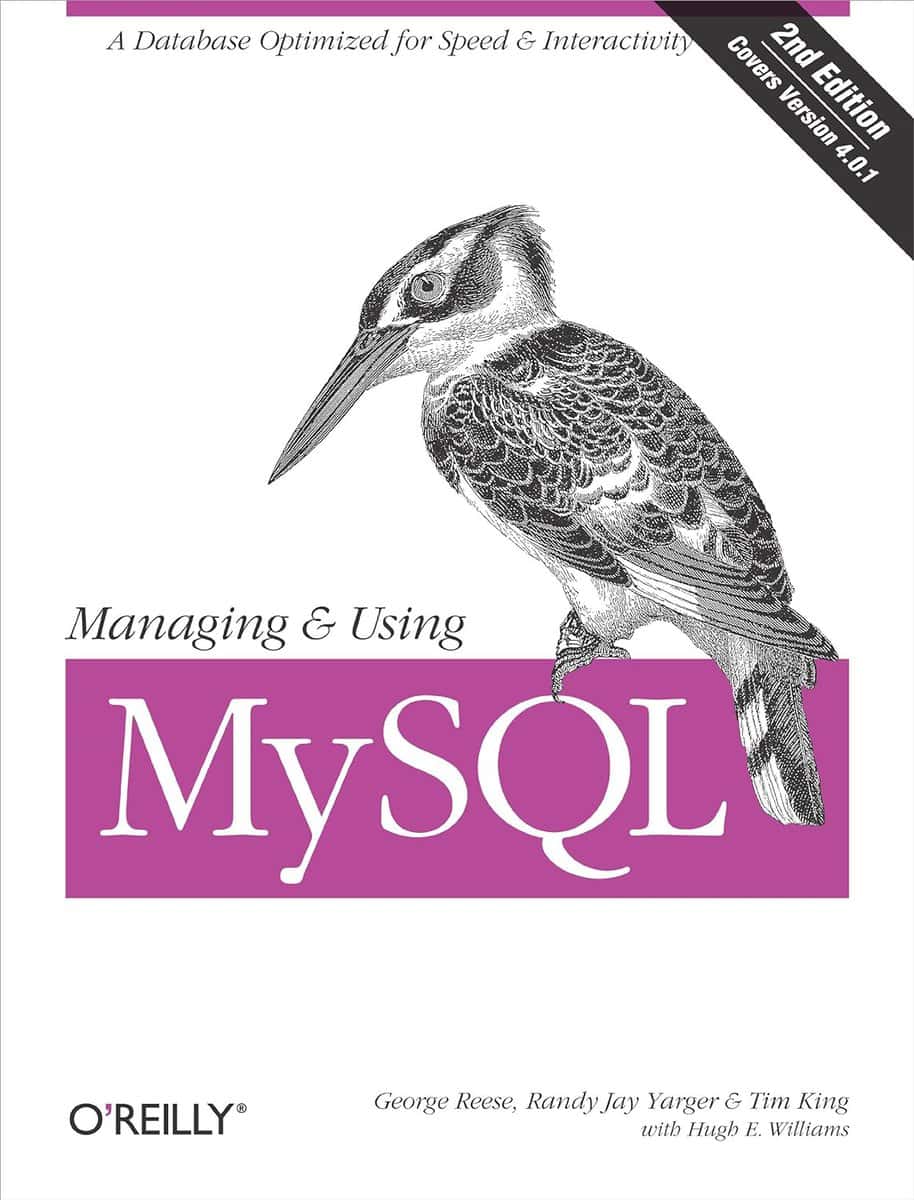
This book is primarily for two classes of readers. The most obvious is the reader interested in using MySQL and mSQL, and the other is anyone who wants to learn about relational database administration and programming without spending dollars by enrolling in a course. This book is an excellent starting point and is the perfect guide for you.
Table of Contents
I. Getting Started with MySQL and mSQL
- Introduction to Relational Databases
- Database Design
- Installation of MySQL and mSQL
- MySQL
- mSQL
- SQL According to MySQL and mSQL
- Other Mid-Range Database Engines
II. Database Programming
- Database Application Architectures
- CGI Programming
- Perl
- Python
- PHP and Other Support for Database-driven HTML
- C and C++
- Java and JDBC
III. Reference
- SQL Reference
- MySQL and mSQL System Variables
- MySQL and mSQL Programs and Utilities
- PHP and Lite Reference
- C Reference
- Python Reference
- Perl Reference
- JDBC Reference
8. MySQL Pocket Reference

The MySQL Pocket Reference is a brisk reference that you can take with you anyplace you go. Rather than racking your mind for the specific linguistic structure of a variant of altering a table that you most often never use, you can venture into your PC case and get this reference. As an accomplished MySQL planner, executive, or software engineer, you can look to this reference. It has all the necessary and fundamental topics that you need daily.
Table of Contents
MySQL 5
- Views
- Triggers
- Stored Procedures
- Cursors
- New Storage Engines
- Database Events
Setup
- Downloading MySQL
- Configuration
- Startup
- Set the Root Password
- Replication
Command-Line Tools
Data Types
- Numerics
- Strings
- Dates
- Complex Types
SQL
- Case Sensitivity
- Literals
- Identifiers
- Comments
- Commands
- Transaction Rules
Operators
- Rules of Precedence
- Arithmetic Operators
- Comparison Operators
- Logical Operators
Functions
- Aggregate Functions
- General Functions
Storage Engines
Stored Procedures and Functions
- Parameters
- Logic
- Handlers and Conditions
9. Microsoft Azure SQL Database Step-by-Step

This specific SQL book gives a sorted-out walkthrough of the SQL Database stage. When you have completed the primary section of this book, you will have the option to make your first SQL Database on Microsoft Azure.
SQL Database is a huge theme, yet here, each section is painstakingly created to handle each topic in turn, with simple-to-follow systems that put absorbable ideas to prompt applied use. In each chapter, your knowledge will build as you learn about configuration, security, migration, reporting, backup, and more.
Table of Contents
- Chapter 1 – Getting Started with Microsoft Azure SQL Database
- Chapter 2 – Configuration and Pricing
- Chapter 3 – Differences between SQL Server and Microsoft Azure SQL Database
- Chapter 4 – Migrating Databases
- Chapter 5 – Security and backup
- Chapter 6 – Cloud reporting
- Chapter 7 – Microsoft Azure SQL Data Sync
- Chapter 8 – Designing and tuning for scalability and high performance
- Chapter 9 – Monitoring and Management
- Chapter 10 – Building Cloud Solutions
10. SQL Queries For Mere Mortals
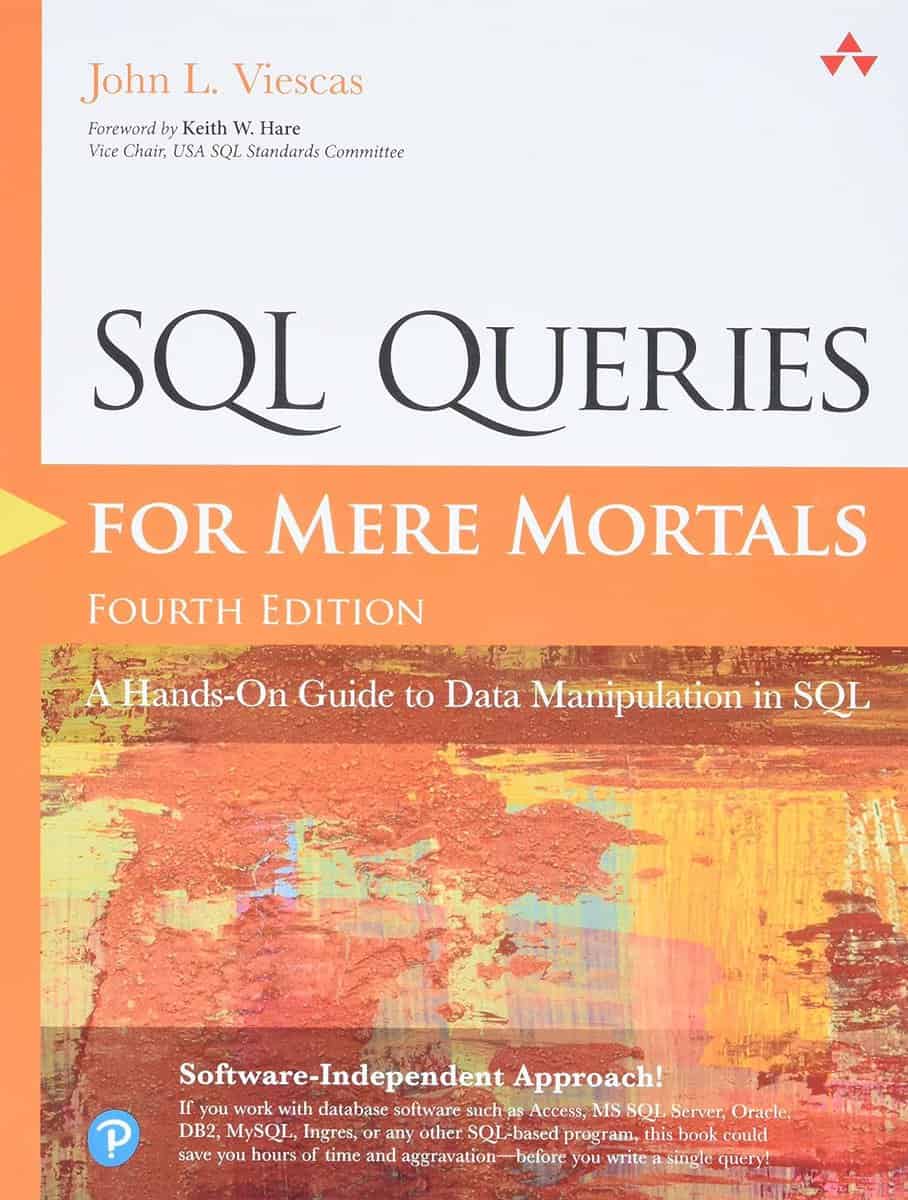
Presently, except if you are working at an amazingly propelled level, this is the primary SQL book you should use to learn SQL. This book will enable you to think clearly about how you can do something. The author of this book has explained the principles and techniques with high clarity.
It gives a bit-by-bit, simple-to-peruse prologue to composing SQL questions. There are hundreds of examples with detailed explanations, and thereby, it prepares you to understand, modify, and create SQL queries on your own.
Table of Contents
PART I: RELATIONAL DATABASES AND SQL
- Chapter 1: What Is Relational?
- Chapter 2: Ensuring Your Database Structure Is Sound
- Chapter 3: A Concise History of SQL
PART II: SQL BASICS
- Chapter 4: Creating a Simple Query
- Chapter 5: Getting More Than Simple Columns
- Chapter 6: Filtering Your Data
PART III: WORKING WITH MULTIPLE TABLES
- Chapter 7: Thinking in Sets
- Chapter 8: INNER JOINs
- Chapter 9: OUTER JOINs
- Chapter 10: UNIONs
- Chapter 11: Subqueries
PART IV: SUMMARIZING AND GROUPING DATA
- Chapter 12: Simple Totals
- Chapter 13: Grouping Data
- Chapter 14: Filtering Grouped Data
PART V: MODIFYING SETS OF DATA
- Chapter 15: Updating Sets of Data
- Chapter 16: Inserting Sets of Data
- Chapter 17: Deleting Sets of Data
PART VI: INTRODUCTION TO SOLVING TOUGH PROBLEMS
- Chapter 18: “NOT” and “AND” Problems
- Chapter 19: Condition Testing
- Chapter 20: Using Unlinked Data and “Driver” Tables
- Chapter 21: Performing Complex Calculations on Groups
- Chapter 22: Partitioning Data into Windows
11. Understanding MySQL Internals
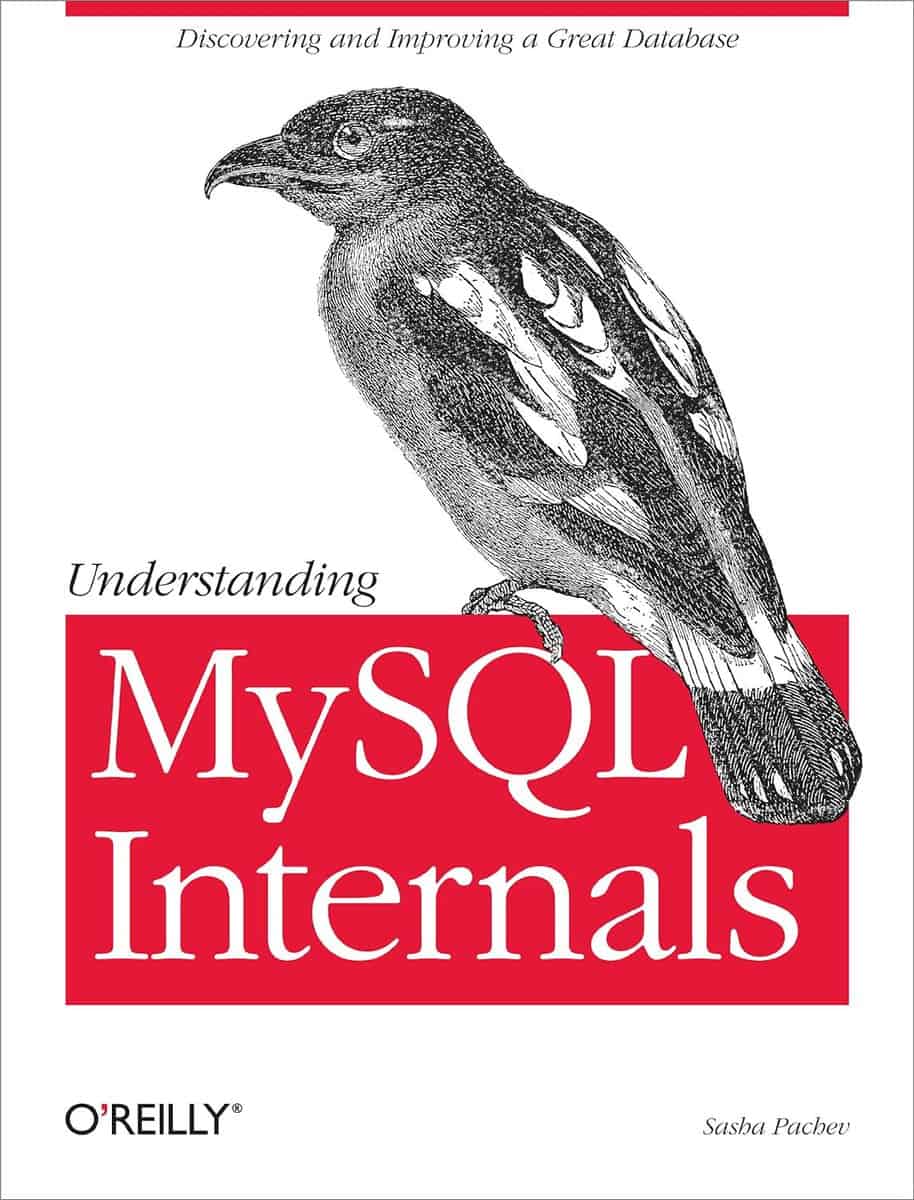
This SQL book is highly recommended for both beginner and intermediate users: those who are trying to extend their knowledge of MySQL, a computer student learning about database kernel development, or even a developer looking for ideas while working on a product that requires extensive database functionality that he must implement himself. Many codes and commands are embedded in the book, which may look intimidating at first, but it rather makes it easier for a reader to understand each topic in depth.
Table of Contents
- MySQL History and Architecture
- Nuts and Bolts of Working with the MySQL Source Code
- Core Classes, Structures, Variables, and APIs
- Client/Server Communication
- Configuration Variables
- Thread-Based Request Handling
- The Storage Engine Interface
- Concurrent Access and Locking
- Parser and Optimizer
- Storage Engines
- Transactions
- Replication
12. SQL Practice Problems
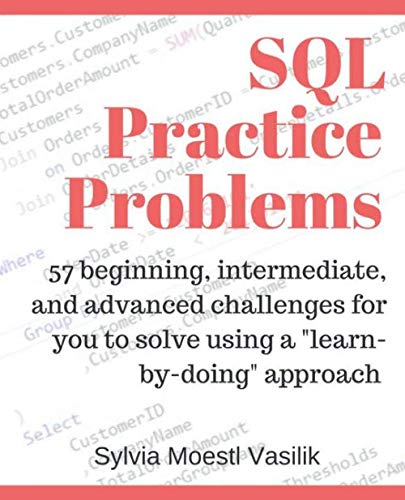
This is one of the best SQL books for brushing up skills and advancing oneself as a developer as it contains all sorts of SQL practice problems, starting from beginner-level questions to gradually introducing the various parts of the SQL Select statement for those with less experience in SQL.
If you’re not a beginner but not sure where you should start, just take a look at the problems and expected results in the Introductory Problems section and make sure you understand the concepts. If you do, start working on the Intermediate Problems section.
In case you’re unsure about how to begin a problem, the clues are intended to walk you through the most effective method to move toward every issue bit by bit. Make a decent attempt to unravel the issues first without the hints given! The data will stick better if you can manage to do that. But in case you’re stuck with a problem, the insights will make you start in speculation with a data mindset.
Table of Contents
Introductory Problems
- Which shippers do we have?
- Certain fields from Categories
- Sales Representatives
- Sales Representatives in the United States
- Orders placed by specific EmployeeID
- Suppliers and ContactTitles
- Products with “queso” in ProductName
- Orders shipping to France or Belgium
- Orders shipping to any country in Latin America
- Employees, in order of age
- Showing only the Date with a DateTime field
- Employees full name
- OrderDetails amount per line item
- How many customers?
- When was the first order?
- Countries where there are customers
- Contact titles for customers
- Products with associated supplier names
- Orders and the Shipper that was used
Intermediate Problems
- Categories and the total products in each
category - Total customers per country/city
- Products that need reordering
- Products that need reordering continued
- Customer list by region
- High freight charges
- High freight charges – 2015
- High freight charges with between
- High freight charges – last year
- Inventory list
- Customers with no orders
- Customers with no orders for EmployeeID 4
Advanced Problems
- High-value customers
- High-value customers – total orders
- High-value customers – with discount
- Month-end orders
- Orders with many line items
- Orders – a random assortment
- Orders – accidental double-entry
- Orders – accidental double-entry details
- Orders – accidental double-entry details, derived table
- Late orders
- Late orders – which employees?
- Late orders vs. total orders
- Late orders vs. total orders – missing employee
- Late orders vs. total orders – fix null
- Late orders vs. total orders – the percentage
- Late orders vs. total orders – fix decimal
- Customer grouping
- Customer grouping – fix null
- Customer grouping with the percentage
- Customer grouping – flexible
- Countries with suppliers or customers
- Countries with suppliers or customers, version 2
- Countries with suppliers or customers – version 3
- First-order in each country
- Customers with multiple orders in 5 day period
- Customers with multiple orders in 5 day period, version 2
13. A Developer’s Guide to Data Modeling for SQL Server
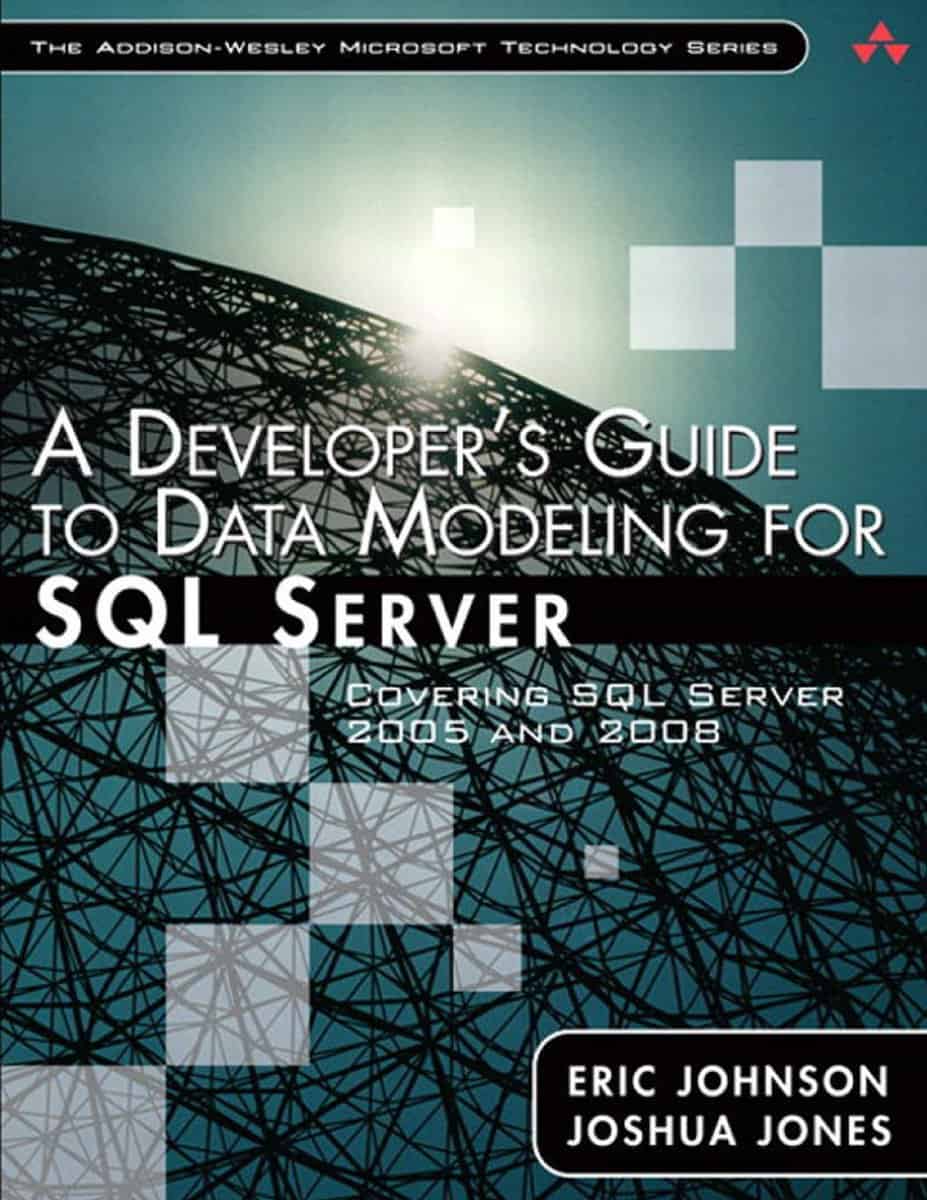
A Developer’s Guide to Data Modeling for SQL Server is written for a database-centric audience. As you start reading this book, you will begin with a concise, practical overview of the core data modeling techniques. This book clarifies the ideas and practice of information displaying with a lucidity that makes the technology open to anybody building databases and information-driven applications.
Table of Contents
PART I: DATA MODELING THEORY
- Chapter 1 Data Modeling Overview
- Chapter 2 Elements Used in Logical Data Models
- Chapter 3 Physical Elements of Data Models
- Chapter 4 Normalizing a Data Model
PART II: BUSINESS REQUIREMENTS
- Chapter 5 Requirements Gathering
- Chapter 6 Interpreting Requirements
PART III: CREATING THE LOGICAL MODEL
- Chapter 7 Creating the Logical Model
- Chapter 8 Common Data Modeling Problems
PART IV: CREATING THE PHYSICAL MODEL
- Chapter 9 Creating the Physical Model with SQL Server
- Chapter 10 Indexing Considerations
- Chapter 11 Creating an Abstraction Layer in SQL Server
- SQL SERVER 2008 RESERVED WORDS
14. Beginning PHP and MySQL From Novice to Professional

If you are someone who wants to learn something all through one book, then this MySQL book will be the key to your success. Starting from teaching PHP, it moves to object-oriented PHP and also how you can use MySQL with PHP.
It teaches you all the basics of MySQL and some advanced topics that will help you become a professional in this field. MySQL often comes in pairs with PHP, so knowing both will keep you at the top of the job search and interviews.
Table of Contents
- Chapter 1: Introducing PHP
- Chapter 2: Configuring Your Environment
- Chapter 3: PHP Basics
- Chapter 4: Functions
- Chapter 5: Arrays
- Chapter 6: Object-Oriented PHP
- Chapter 7: Advanced OOP Features
- Chapter 8: Error and Exception Handling
- Chapter 9: Strings and Regular Expressions
- Chapter 10: Working with the File and Operating System
- Chapter 11: PEAR
- Chapter 12: Date and Time
- Chapter 13: Working with HTML Forms
- Chapter 14: Authenticating Your Users
- Chapter 15: Handling File Uploads
- Chapter 16: Networking
- Chapter 17: PHP and LDAP
- Chapter 18: Session Handlers
- Chapter 19: Templating with Smarty
- Chapter 20: Web Services
- Chapter 21: Securing Your Web Site
- Chapter 22: Creating Ajax-enhanced Features with jQuery and PHP
- Chapter 23: Building Web Sites for the World
- Chapter 24: Introducing the Zend Framework
- Chapter 25: Introducing MySQL
- Chapter 26: Installing and Configuring MySQL
- Chapter 27: The Many MySQL Clients
- Chapter 28: MySQL Storage Engines and Data Types
- Chapter 29: Securing MySQL
- Chapter 30: Using PHP with MySQL
- Chapter 31: Introducing PDO
- Chapter 32: Stored Routines
- Chapter 33: MySQL Triggers
- Chapter 34: MySQL Views
- Chapter 35: Practical Database Queries
- Chapter 36: Indexes and Searching
- Chapter 37: Transactions
- Chapter 38: Importing and Exporting Data
15. Expert MySQL

Whether you are a beginner at learning MySQL or someone who has worked with a database system for years, by reading this MySQL book, you will get a lot out of it. It is the best SQL book for someone who wants to extend their knowledge of MySQL.
The last part of the book includes a crucial topic, Advanced Database Internals, which will teach you how to optimize and execute your queries. So, it is highly suggested that you do not roll over this book.
Table of Contents
Part 1: Getting Started with MySQL Development
- Chapter 1: MySQL and The Open Source Revolution
- Chapter 2: The Anatomy of a Database System
- Chapter 3: A Tour of the MySQL Source Code
- Chapter 4: Test-Driven MySQL Development
Part 2: Extending MySQL
- Chapter 5: Debugging
- Chapter 6: Embedded MySQL
- Chapter 7: Adding Functions and Commands to MySQL
- Chapter 8: Extending MySQL High Availability
- Chapter 9: Developing MySQL Plugins
- Chapter 10: Building Your Own Storage Engine
Part 3: Advanced Database Internals
- Chapter 11: Database System Internals
- Chapter 12: Internal Query Representation
- Chapter 13: Query Optimization
- Chapter 14: Query Execution
16. The Definitive Guide to MySQL 5
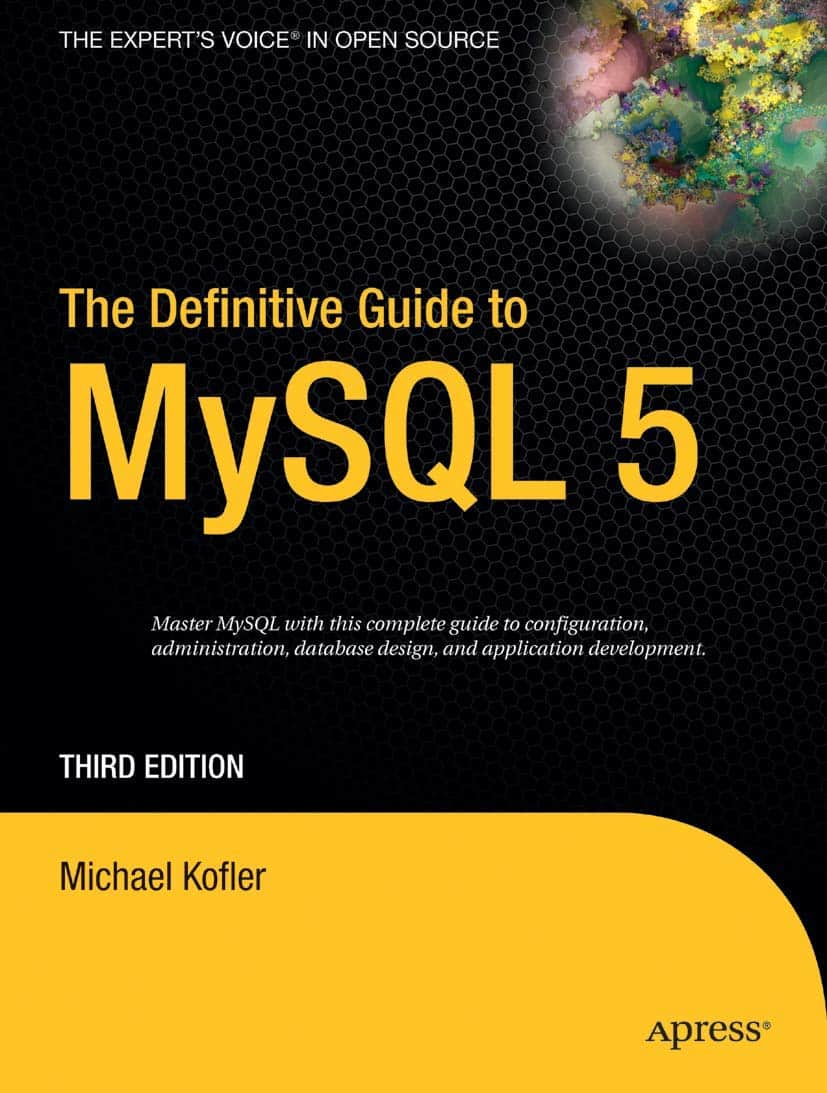
This book will expose you to MySQL’s impressive array of new features: views, stored procedures, triggers, and spatial data types without requiring you to have any previous knowledge of SQL or database design. The introductory part of the book begins with an extensive introduction to installing MySQL, Apache, PHP, and Perl under Windows and Linux.
The second part of the book introduces the most important administrative tools and user interfaces: MySQL, mysqladmin, mysqldump, the programs MySQL Administrator, MySQL Query Browser; and finally phpMyAdmin.
Part 3 provides a large amount of background material on the database language SQL, the proper design of databases, stored procedures, etc. In Part 4, “Programming,” the language PHP is emphasized. A number of example programs show how to use the interfaces MySQL and mysqli.
Table of Contents
PART 1 Introduction
- CHAPTER 1 What Is MySQL?
- CHAPTER 2 The Test Environment
- CHAPTER 3 Introductory Example (An Opinion Poll with PHP)
PART 2 Administrative Tools and User Interfaces
- CHAPTER 4 MySQL, mysqladmin, and mysqldump
- CHAPTER 5 MySQL Administrator and MySQL Query Browser
- CHAPTER 6 phpMyAdmin
- CHAPTER 7 Microsoft Office, OpenOffice/StarOffice
PART 3 Fundamentals
- CHAPTER 8 Database Design
- CHAPTER 9 An Introduction to SQL
- CHAPTER 10 SQL Recipes
- CHAPTER 11 Access Administration and Security
- CHAPTER 12 GIS Functions
- CHAPTER 13 Stored Procedures and Triggers
- CHAPTER 14 Administration and Server Configuration
PART 4 Programming
- CHAPTER 15 PHP
- CHAPTER 16 Perl
- CHAPTER 17 Java (JDBC and Connector/J)
- CHAPTER 18 C
- CHAPTER 19 Visual Basic 6/VBA
- CHAPTER 20 Visual Basic .NET and C#
17. MySQL Administrator’s Bible

Just as the name of the book says, this MySQL book is literally a bible for those who are overwhelmed to learn MySQL. Just like how a baby is taught how to walk, this book will guide you like that while teaching MySQL.
It presents comprehensive coverage of such topics as MySQL server tuning, managing users, index tuning, database, performance monitoring, security, managing storage engines, caching, backup, recovery, and more. Someone who already has knowledge of MySQL will also benefit from this book, as it also has topics for extending your skills on MySQL.
Table of Contents
Part I First Steps with MySQL
- Chapter 1: Introduction to MySQL
- Chapter 2: Installing and Upgrading MySQL Server
- Chapter 3: Accessing MySQL
Part II Developing with MySQL
- Chapter 4: How MySQL Extends and Deviates from SQL
- Chapter 5: MySQL Data Types
- Chapter 6: MySQL Index Types
- Chapter 7: Stored Routines, Triggers, and Events
- Chapter 8: MySQL Views
- Chapter 9: Transactions in MySQL
Part III Core MySQL Administration
- Chapter 10: MySQL Server Tuning
- Chapter 11: Storage Engines
- Chapter 12: Caching with MySQL
- Chapter 13: Backups and Recovery
- Chapter 14: User Management
- Chapter 15: Partitioning
- Chapter 16: Logging and Replication
- Chapter 17: Measuring Performance
Part IV Extending Your Skills
- Chapter 18: Query Analysis and Index Tuning
- Chapter 19: Monitoring Your Systems
- Chapter 20: Securing MySQL
- Chapter 21: The MySQL Data Dictionary
- Chapter 22: Scaling and High Availability Architectures
- Appendix A: MySQL Proxy
- Appendix B: Functions and Operators
- Appendix C: Resources
18. PHP Programming With MySQL
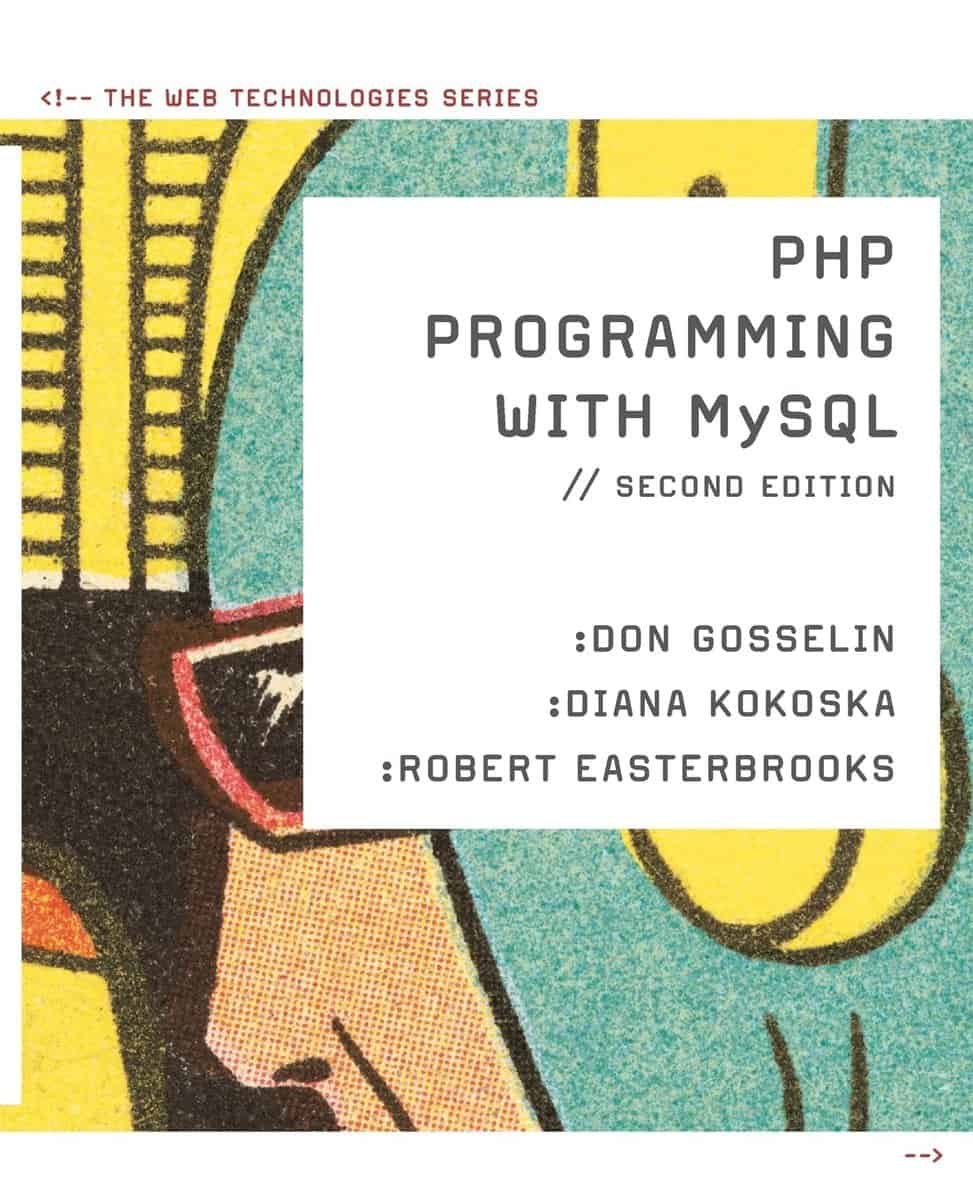
This book is extremely helpful for beginners who have zero knowledge of PHP or MySQL. This book covers the basics of PHP and MySQL along with introductions to advanced topics, including object-oriented programming and how to build Web sites that incorporate authentication and security. So, it is definitely a must-read for those who want to start learning and have no clue where to begin.
Table of Contents
- CHAPTER 1 Getting Started with PHP
- CHAPTER 2 Functions and Control Structures
- CHAPTER 3 Manipulating Strings
- CHAPTER 4 Handling User Input
- CHAPTER 5 Working with Files and Directories
- CHAPTER 6 Manipulating Arrays
- CHAPTER 7 Working with Databases and MySQL
- CHAPTER 8 Manipulating MySQL Databases with PHP
- CHAPTER 9 Managing State Information
- CHAPTER 10 Developing Object-Oriented PHP
19. MySQL Cookbook
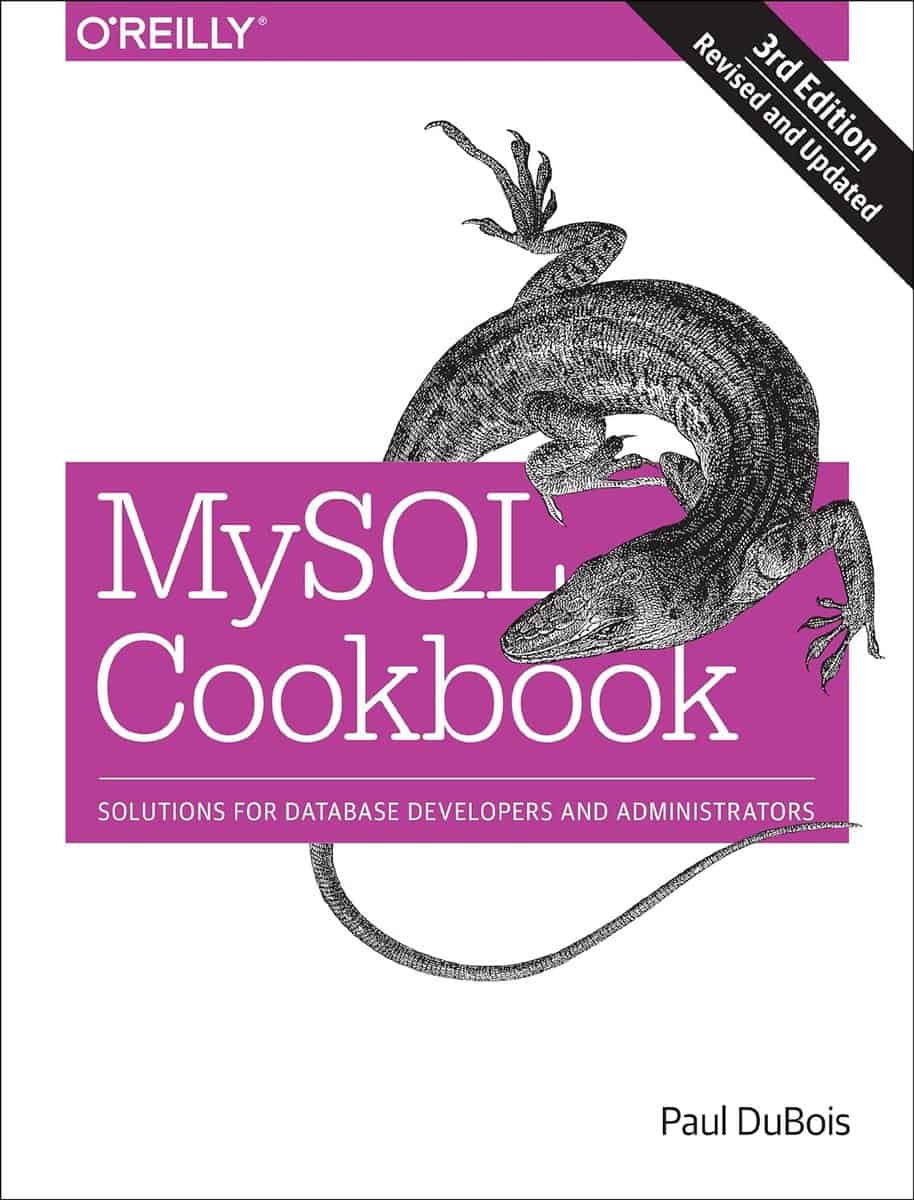
MySQL’s ubiquity brings up the need to address issues its clients have about how to tackle explicit issues. What this book does is that it fills in as a convenient asset to which you can turn for speedy arrangements or strategies for assaulting specific kinds of inquiries that arise when you use MySQL. Therefore, it is super handy and beneficial if you are deciding to use more of MySQL with hundreds of problems in hand already.
Table of Contents
- Chapter 1. Using the MySQL Client Program
- Chapter 2. Writing MySQL-Based Programs
- Chapter 3. Record Selection Techniques
- Chapter 4. Working with Strings
- Chapter 5. Working with Dates and Times
- Chapter 6. Sorting Query Results
- Chapter 7. Generating Summaries
- Chapter 8. Modifying Tables with ALTER TABLE
- Chapter 9. Obtaining and Using Metadata
- Chapter 10. Importing and Exporting Data
- Chapter 11. Generating and Using Sequences
- Chapter 12. Using Multiple Tables
- Chapter 13. Statistical Techniques
- Chapter 14. Handling Duplicates
- Chapter 15. Performing Transactions
- Chapter 16. Introduction to MySQL on the Web
- Chapter 17. Incorporating Query Results into Web Pages
- Chapter 18. Processing Web Input with MySQL
- Chapter 19. Using MySQL-Based Web Session
Management
20. Pro MySQL
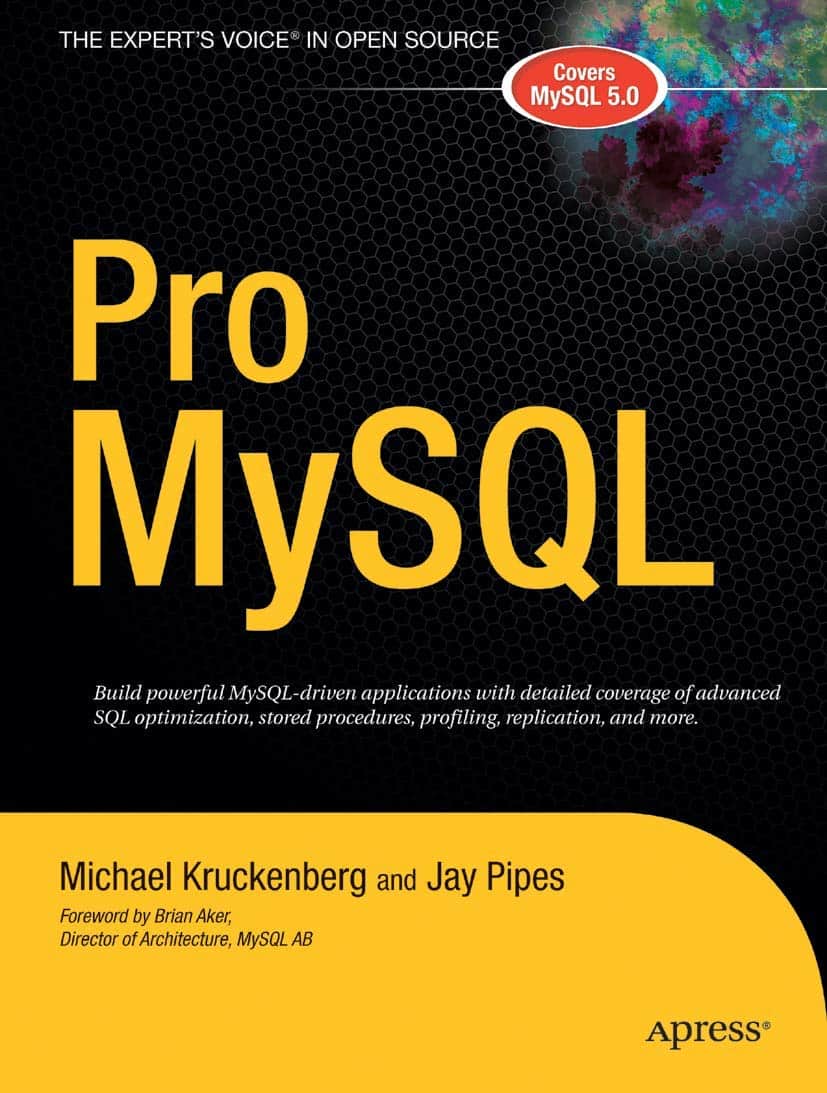
As the name of the book goes, this book is a masterpiece for intermediate and advanced MySQL users who strive to put the finishing touches on their education. This book will take you from apprentice to journeyman, so to speak, and can be said to be the best SQL book for you. It is a very lucid and well-organized book. Therefore, you do not have to be scared.
Table of Contents
PART 1 Design and Development
- CHAPTER 1 Analyzing Business Requirements
- CHAPTER 2 Index Concepts
- CHAPTER 3 Transaction Processing
- CHAPTER 4 MySQL System Architecture
- CHAPTER 5 Storage Engines and Data Types
- CHAPTER 6 Benchmarking and Profiling
- CHAPTER 7 Essential SQL
- CHAPTER 8 SQL Scenarios
- CHAPTER 9 Stored Procedures
- CHAPTER 10 Functions
- CHAPTER 11 Cursors
- CHAPTER 12 Views
- CHAPTER 13 Triggers
PART 2 Administration
- CHAPTER 14 MySQL Installation and Configuration
- CHAPTER 15 User Administration
- CHAPTER 16 Security
- CHAPTER 17 Backup and Restoration
- CHAPTER 18 Replication
- CHAPTER 19 Cluster
- CHAPTER 20 Troubleshooting
- CHAPTER 21 MySQL Data Dictionary
Finally, Insight
SQL is one of the main languages used to store and retrieve data from the database, and it has many users. To make things more innovative and easy in this modern world, thousands of programmers use SQL. Learning this language by heart has become very crucial for us, and therefore, we have brought in front of you all these wonderfully written SQL books that will make it almost effortless for you to learn SQL.
We hope you can find the best SQL book that is perfectly suited for you among these. We are confident that you will get the best possible rules that you have to learn SQL in the wake of perusing these books.
Finally, if you have any kind of suggestions, please do not hesitate to comment below. We likewise trust you will impart our endeavors to other people so individuals can serenely connect for this list of best SQL books.
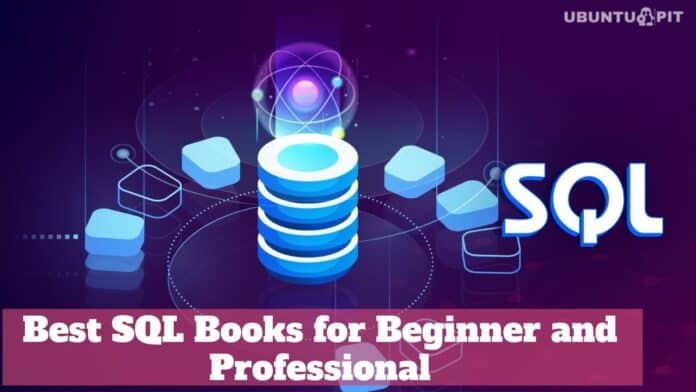
I’m not sure when it was published, but, thanks for the list! 🙂 I’ve only missed some book for PostgreSQL!
I read some of these books. However, you have to admit that SQL is not a great object for a book – they are usually just boring. I recommend tracking cool themed blogs. But books are always important and you need to know some of them.
Could you please suggest any? I am completely new. Thanks